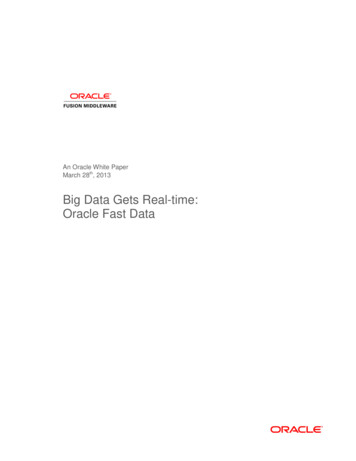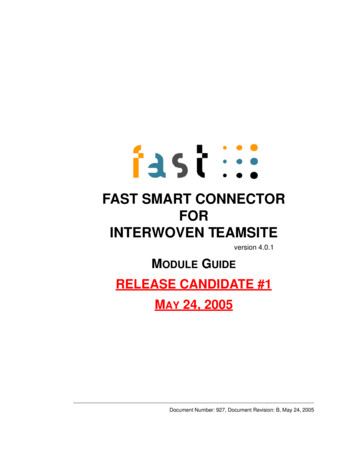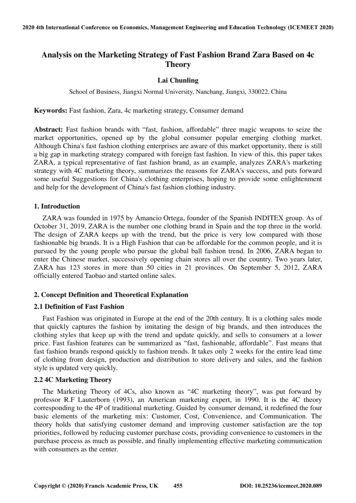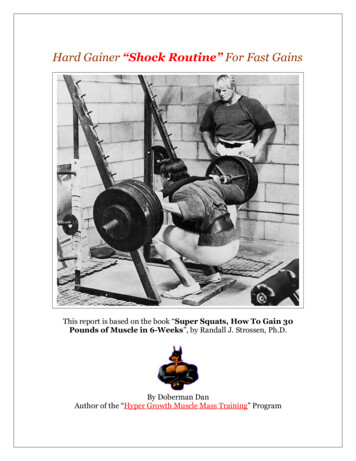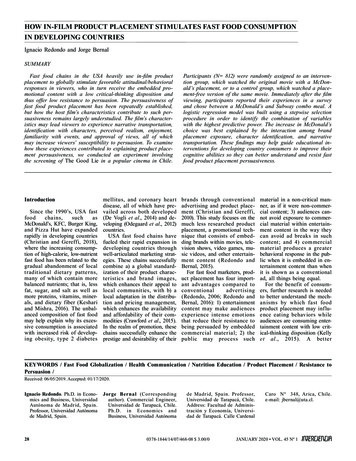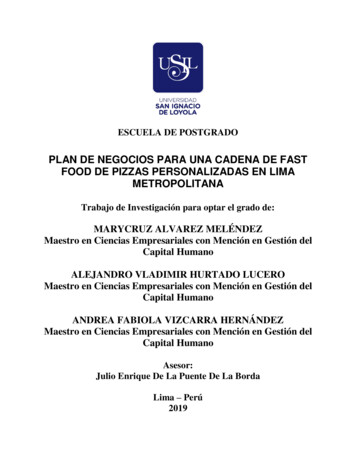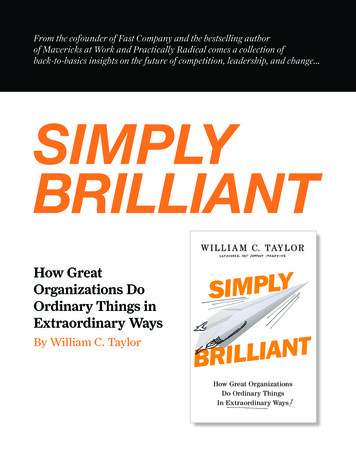
Transcription
From the cofounder of Fast Company and the bestselling authorof Mavericks at Work and Practically Radical comes a collection ofback-to-basics insights on the future of competition, leadership, and change SIMPLYBRILLIANTHow GreatOrganizations DoOrdinary Things inExtraordinary WaysBy William C. Taylor
PRAISE FOR SIMPLY BRILLIANT“I need at least a thousand words to begin to explain why I love this book so much.Greatness (!) from real people (!) in the most un-Silicon Valley (!) markets and locationsimaginable. Wow!”—Tom Peters, coauthor of In Search of Excellence“This book will challenge you to look at yourself, your work, and the world aroundyou with fresh eyes and a more open mind.”—Sir Ken Robinson, educator and author ofCreative Schools: The Grassroots Revolution that’s Transforming Education“A clear and instructive manual for disruption that also happens to be a terrific read.Bill Taylor has defined parameters for innovation that are relevant and actionablewhether your goal is to grow a business or cure a disease.”—Deborah W. Brooks, Co-Founder and Executive Vice Chairman,The Michael J. Fox Foundation for Parkinson’s Research“Bill Taylor is back—and he’s better than ever! Brimming with fascinating case studies,this book is essential reading for leaders in every industry.”—Daniel H. Pink, author of Drive and To Sell Is Human“I have followed Bill Taylor since the early days of Fast Company, and have used hisideas in the turnaround of Hudson’s Bay Company. I’m a believer!”—Bonnie Brooks, Vice Chairman of Hudson’s Bay Company2 SIMPLY BRILLIANT
TABLE OF CONTENTSPROLOGUEThe New Story of Success“The Possible Is Immense”PART ISTOP TRYING TO BE THE BEST,STRIVE TO BE THE ONLYThe most successful organizations champion the most compelling ideas,and do things that other organizations can’t or won’t do.CHAPTER ONEWhat’s Your Values Proposition?“Competition Is Not the Same as Choice”CHAPTER TWOWhy Missionaries Beat Mercenaries (and Passion Beats Drive)“Some Things Have to Be Believed to Be Seen”PART IIDON’T LET WHAT YOU KNOW LIMITWHAT YOU CAN IMAGINEIn a world being remade before our eyes, leaders who make a big difference are theones who challenge the logic of their field—and of their own success.CHAPTER THREEBeyond the Paradox of Expertise“Too often, pride in your most recent idea becomes a barrier to seeing the next idea”CHAPTER FOURInteresting Matters, Interested is Mandatory“When’s the last time you did something for the first time?”3 SIMPLY BRILLIANT
PART IIIIT’S JUST AS IMPORTANT TO BE KIND AS CLEVERIn an era of brash ideas and disruptive technology, simple acts of connectionand compassion take on outsized importance.CHAPTER FIVECivility Is Not the Enemy of Productivity“People deserve to be treated like people”CHAPTER SIXThe Tough-Minded Case for Leading with Love“We want people to know what true happiness feels like”PART IVTHE ALLIES YOU ENLIST MATTERMORE THAN THE POWER YOU EXERTOrganizations that make the most dramatic progress are the ones that invite ordinary people tomake extraordinary contributions, and whose leaders are as humble as they are hungryCHAPTER SEVENSerendipity As a Way of Life“We prize collisions over convenience”CHAPTER EIGHTNobody Wins Unless Everybody Wins“Create more value than you capture”EPILOGUEWhat’s Your Story?“Work hard at work worth doing”ENDNOTESACKNOWLEDGEMENTSINDEX4 SIMPLY BRILLIANT
PROLOGUEThe New Story of Success“The Possible Is Immense”Who doesn’t want to be part of a great success story? To run, start, or play aleadership role in a company that wins big and changes the course of its industry.To launch a brand that dazzles customers and dominates its market. To be the kindof executive or entrepreneur who creates jobs, generates wealth, and builds anorganization bursting with energy and creativity.These days, in the popular imagination, the quest for success has becomesynonymous with the spread of disruptive technologies and viral apps, with the rise ofradical business models and new-fangled work arrangements. This is the stuff that fuelsthe dreams of countless engineers and venture capitalists in Silicon Valley, and inspireshard-charging innovators such as Facebook’s Mark Zuckerberg and Uber’s TravisKalanick. The “new economy,” the story goes, belongs to a new generation of companiesand leaders who have little in common with what came before.But why should the story of success be the exclusive domain of a fewtechnology-driven startups or a handful of young billionaires? The story of this book,its message for leaders who aim to do something important and build something great,is both simple and subversive: In a time of wrenching disruptions and exhilarating5 SIMPLY BRILLIANT
advances, of unrelenting turmoil and unlimited promise, the future is open toeverybody. The thrill of breakthrough creativity and breakaway performance doesn’tjust belong to the youngest companies with the most cutting-edge technology or themost radical business strategies. It can be summoned in all sorts of industries and allwalks of life, if leaders can reimagine what’s possible in their fields.What I have come to understand, what I have tried to bring to life in mymessages and case studies, is that it is possible to turn even the most familiarofferings, in some of the world’s most traditional settings, into products, services,and experiences that are genuinely remarkable. This is not, I concede, a widely heldpoint of view, even among leaders in those fields. I’ve heard the same reservationstime and again, from executives in long-established industries who are reluctantto contemplate a dramatic break from the past: “This place has been around fora hundred years, we’re not Google or Amazon,” they tell me. Or, “This is not aglamorous business, we can’t be a passion brand like Apple or Starbucks.”Their real message: Don’t blame me for being average or old-fashioned,I’m not from Silicon Valley or Seattle. To which I reply: Don’t use your company’sage or industry as an excuse for mediocrity. There is no such thing as an averageor old-fashioned business, just average or old-fashioned ways to do business.In fact, the opportunity to reach for extraordinary may be most pronounced insettings that have been far too ordinary for far too long. If how you think shapeshow you compete, then it should be easier to compete in fields locked into oldways of thinking.Why this story now? Because we have entered a new era of business andleadership, an era defined less by advanced technology than by ever-advancingcompetitive intensity. When customers have higher expectations than ever, whenrivals are more capable than ever, when choices, options, and brands are morenumerous than ever, then familiar strategies and comfortable ways of working areless effective than ever. In any industry, especially in long-established industries,leaders who make waves and make their mark are the ones who rethink whatthey’ve always done, who refresh and reinterpret the products and experiencesthey offer, who invite new voices into the conversation about the future of theirorganization.6 SIMPLY BRILLIANT
Thomas L. Friedman, the agenda-setting New York Times columnist, hascoined a phrase that nicely captures the tenor of these demanding times. “Today,” heargues, “average is officially over. Being average just won’t earn you what it used to.It can’t when so many more employers have so much more access to so much moreabove-average cheap foreign labor, cheap robotics, cheap software, cheap automationand cheap genius. Therefore, everyone needs to find their extra—their unique valuecontribution that makes them stand out.”This phenomenon is being played out across the economy and around theworld, with huge consequences for those who fail to reckon with it. Lior Arussy,one of the most provocative business thinkers I know, advises some of the world’smost prominent companies on the relationship between strategy, innovation, andgrowth. The problem with most organizations and brands, Arussy likes to say, is notthat they are broken. It’s that they are boring. And boring organizations don’t lendthemselves to runaway success.“We are living in a new world,” he argues. “Customers no longer accept an‘okay’ job. It’s exceptional or nothing. In most fields, what was once exciting quicklybecomes boring, and boring becomes annoying. ‘Impress me, surprise me, dosomething I will remember’—that’s what customers want. That’s what organizationshave to deliver.”Truth be told, even in a world in which “average is over,” the choice facingleaders in most fields is not between one-of-a-kind creativity and end-of-timescalamity. The more likely outcome is something closer to endless (and endlesslyfrustrating) mediocrity. Despite our fascination with digital disruption, radicalreinvention, and the merciless logic of survival of the fittest, countless organizationsendure for decades in the face of bland results. The status quo is surprisinglypowerful, and not always fatal.“There are many organizations whose performance, by any standard, fallsshort of the expectations of owners, members, and clients,” sociologists Marshall W.Meyer and Lynne G. Zucker remind us, “yet whose existence continues, sometimesindefinitely.” In such “permanently failing organizations,” their delightfullyexpressive turn-of-phrase, executives avoid extinction, even as they excite almost noone. The day-to-day reality is one of “sustained low performance” rather than deep7 SIMPLY BRILLIANT
seated crisis, a kind of active inertia driven by short-term self-interest, rather thanpurposeful change driven by a shared drive to excel.In other words, with apologies to that memorable scene from the movie Apollo13, failure is an option, if by that we mean a failure to make the most of the ideas, people,and technologies available to us. This quiet brand of failure—a failure of imagination,a failure of nerve, a failure to muster the will to break from the past—has become afamiliar part of the business landscape. Harvard Business School Professor Linda Hill,faculty chair of its Leadership Initiative, has argued that run-of-the-mill executives focuson closing “performance gaps”—the difference between what is and what should be.This is the work of efficiency, productivity, improving on the past. But the real action, thetrue agenda for leaders, is in closing “opportunity gaps”—the difference between what isand what could be. This is the work of innovation, transformation, inventing the future.Merely surviving is not the same as truly thriving.Simply Brilliant is addressed to leaders who are determined to thrive, not justsurvive, who aim to write compelling stories of success no matter their industry orfield of endeavor. It is organized into four sections, each of which can be read on itsown, all of which set out essential principles for exceptional performance—simple,direct, counter-intuitive insights that define a new agenda for strategy, innovation,service, and shared prosperity. My hope is that the material is both instructiveand inspiring. Instructive in that it delivers a set of messages and lessons that canbe applied immediately, inspiring in that it highlights a cast of characters whoseambitions are bold and whose track record is without peer, and who toil in settingsthat are familiar and relatable.I traveled thousands of miles during the research for this book, from London,England to Anchorage, Alaska, from the bright lights of Las Vegas to a quiet townon the banks of the Mississippi River, searching for new kinds of success storiesthat illuminate the new era we’ve entered. I spent long days touring factories,visiting retail outlets, sitting in on meetings, to observe the work of big companies,entrepreneurial outfits, nonprofit groups, and social-change movements. These 15organizations were from very different fields and had wildly different histories andcultures, but they shared a defining trait: Their leaders were determined to achievesomething important by doing even the most ordinary things in extraordinary ways.8 SIMPLY BRILLIANT
I have tried to bring to these stories what John W. Gardner, the legendarypublic intellectual, called “tough-minded optimism.” The future, Gardner wrote, “isnot shaped by people who don’t really believe in the future.” Rather, “it is created byhighly motivated people, by enthusiasts, by men and women who want somethingvery much or believe very much.”Of course, even tough-minded optimists have to face problems,disappointments, crises. That’s the pressure that goes with breaking new ground,making big change, doing things that haven’t been done that way before. I haveno doubt that one or two of the organizations I chronicle will experience setbacksthat they (and I) did not anticipate. But what I want very much, what I believe verymuch, is that the ideas and characters you’ll encounter in this book will fuel yourenthusiasm to do extraordinary things rather than muddle though in a state of“permanent failure.”On one of my last visits for Simply Brilliant, I traveled to Euclid, Ohio, asuburb of Cleveland, to spend time with a company I’d been eager to study for years.Lincoln Electric is one of America’s great manufacturers, a globally successfulproducer of welding equipment and cutting machinery founded back in 1895.Lincoln Electric doesn’t make many headlines, but it has made history since 1958 byvowing never to lay off a single employee and, since 1934, by sharing a big chunk ofits profits with its Cleveland-area employees. In a decidedly unglamorous field, andin the face of recessions, financial collapses, and rapid technology shifts, LincolnElectric has achieved something unrivaled by recognizing that people are at theirmost productive when they get a piece of the action and a seat at the table.As I walked from the corporate offices, after a conversation with the CEO, totour the company’s massive factory complex, I saw a big sign in capital letters witha message from James F. Lincoln, the younger brother of the company’s founder,and the visionary behind the company’s social system and business model. THEACTUAL IS LIMITED, the sign read. THE POSSIBLE IS IMMENSE.That is the spirit of this book. That is the story of success.What’s your story?9 SIMPLY BRILLIANT
EPILOGUEWhat’s Your Story?“Work Hard at Work Worth Doing”More than a century ago, in his famous Square Deal speech to a Labor Daycelebration in Syracuse, New York, President Theodore Roosevelt offered adefinition of success that has stood the test of time. “Far and away the best prize thatlife offers,” he said, “is the chance to work hard at work worth doing.” In these times,“work worth doing” means work that elevates our sense of impact and enrichesour sense of achievement—work that rewrites the story of success for a new era ofbusiness and leadership.That has been the work of this book, which draws insights and lessonsfrom organizations and leaders in a range of fields that are doing ordinary things inextraordinary ways. But these stories of success are only valuable if they contribute toyour success, if they provide a set of ideas and a collection of practices that equip you tothink bigger, aim higher, and win bigger. Here, then, is a distillation of the core messagesof Simply Brilliant, eight questions whose answers, I hope, will help you to write a morerewarding story for yourself and the organizations you care about.10 SIMPLY BRILLIANT
1. Can you develop a definition of success that allows you to standapart from the competition and inspires others to stand with you?What struck me about every organization and leader I chronicled in Simply Brilliantwas the sense of purpose they exuded, and how that sense of purpose motivatedcolleagues, customers, and allies to contribute to their success. Brand strategistAdam Morgan calls it a “lighthouse identity”—a “very particular take” on whatorganizations are trying to achieve, a “compelling conviction” that their goals are“uniquely theirs” and uniquely important. Venture capitalist John Doerr prefersto invest in entrepreneurs who conduct themselves as “missionaries” as opposedto “mercenaries,” founders who strive not just for success, but for “success andsignificance.”The specifics of the metaphors are less important than the universality of theinsight. The organizations and leaders that create the most value are the ones thatposition themselves as the most alluring alternative to a predictable (albeit efficient)status quo. Metro Bank’s Vernon Hill likes to say, only half in jest, that he operates onthe “lunatic fringe” of his industry—but that’s precisely why so many employees andcustomers get so excited about something as mundane as a retail banking. WhenI sat in on ISMs Day at Quicken Loans, a financial institution with no brick-andmortar branches, founder Dan Gilbert made the same point. “We are zealots” aboutcustomer service, he told his colleagues, “we are on the lunatic fringe.” This not isan argument for lunacy. But it is an argument for uniqueness and intensity: What doyou do that other organizations can’t or won’t do?2. Can you explain, clearly and compellingly, why what you do matters andhow you expect to win?Ultimately, the only sustainable form of leadership is thought leadership—championing an extraordinary set of ideas, not just good-enough products andservices. So leaders who think differently tend to talk differently as well. My FastCompany colleague and Mavericks at Work coauthor Polly LaBarre has observed thattoo many leaders communicate with “jargon monoxide”—empty rhetoric, mindnumbing buzzwords, eye-glazing acronyms. But the leaders we’ve encountered inSimply Brilliant are as precise with their words as they are creative with their ideas.11 SIMPLY BRILLIANT
They understand that they have to explain, in language that is unique to their fieldand compelling to the outside world, why what they do matters and how theyexpect to win.When Rosanne Haggerty challenged her colleagues in the “homelessindustrial complex” to reimagine their strategies for addressing an intractablesocial problem, she led with a vigorous manifesto that spelled out the principles ofthe 100,000 Homes Campaign and invited others to come along. With precise andprovocative language, she and her colleagues explained why they were breakingfrom convention in their field and how they expected to succeed. As I got to knowAlaska’s Southcentral Foundation, and its remarkable work in healthcare, I kepttripping over the term “customer-owners,” which holds a sacred place in theorganization’s vocabulary. “Can’t I call people patients?” I pleaded. “Or customers?”But CEO Katherine Gottlieb was adamant. “We want people to live and breatheownership of their health,” she said, and to recognize that they literally owned thehealth system that delivers care. That’s why she and her colleagues talk the way theydo. Do you know how to “talk the walk?”3. Are you prepared to rethink the conventions of success in your field andthe logic of your success as a leader?The “paradox of expertise” is one of the most dangerous occupational hazards forleaders. In a world being remade before our eyes, leaders who make a differenceare the ones who can rethink what’s possible with their organizations. Yet themore closely you’ve looked at a field, and the longer you’ve been working andsucceeding in it, the more difficult it can be to see new patterns, new prospects,new possibilities. The people with the most experience, knowledge, and resourcesin a particular area are often the last ones to seize opportunities for somethingdramatically new.That’s why this book devoted so much attention to leaders who were notjust disrupting their industries, but also disrupting themselves, leaders who, in thewords of management thinker and jazz musician Frank J. Barrett, practice the art of“provocative competence.” Barrett describes provocative competence as “leadershipthat enlivens activity and rouses the mind to life.” I think of it more simply—as the12 SIMPLY BRILLIANT
capacity to reflect on your career, think hard about the future, and recognize that themindsets and skillsets that got you to where you are probably won’t get you to whereyou want to go.Robert Wennett, the boundlessly creative mind behind 1111 Lincoln Road,challenged almost every assumption in his field to build his one-of-a-kind parkingstructure and civic space in Miami’s South Beach. Wennett took the disruptiveideas behind his creation so seriously, and so personally, that he decided to live inthe structure he built. “People always ask me, ‘Why would you choose to live in aparking garage?’” he cracks. “But the moment they walk in, they never ask again.”How do you make sure that what you know doesn’t limit what you can imagine?4. Are you as determined to stay interested as to be interesting?The most creative leaders I know are not just the boldest thinkers; they are the mostinsatiable learners. In his legendary speech on “Personal Renewal,” John Gardnerexplored what it takes for leaders to stay relevant, effective, and engaged as theyrose through the ranks. “Not anything as narrow as ambition,” he said. “After all,ambition eventually wears out and probably should. But you can keep your zest untilthe day you die.” Translation: As interesting as they may be, the most vital leadersfigure out how to remain interested—in big ideas, in little surprises, in the enduringmission of their enterprise and all new ways to bring that mission to life.Garry Ridge, CEO of WD-40, has built an organization filled with whathe calls “learning maniacs.” He and his colleagues have made an extraordinarycommitment to maintain their “zest” for learning and discovery, to stay interested innew ideas about products and purpose even as they work to make the company andits brands more interesting to the outside world. He actually affixes an electronicsignature to his emails with the message “Ancora Imparo,” Italian for “I am stilllearning”—a favorite phrase of Michelangelo. “My dream,” Ridge says, “is for thisorganization to be viewed as a leadership-and-learning laboratory for business.”What’s your strategy for personal renewal?13 SIMPLY BRILLIANT
5. Do you pay as much attention to psychology and emotion as you do totechnology and efficiency?Nobody is opposed to a good deal—a dollars-and-cents value proposition that makessense. But what we remember, what we appreciate, what we prize, are gestures ofconcern and compassion that introduce a touch of humanity into the all-too-bloodlesscalculations that define so much of modern life. In a world being reshaped by technology,what so many of us crave, what truly stand out, are small gestures of kindness thatremind us what it means to be human. As Mother Theresa famously advised: “Not all ofus can do great things. But we can do small things with great love.”That’s why leaders who aspire to do “great things” never lose sight of thesmall things that make such a huge impression inside and outside the organization.Pret a Manger, the fast-growing, fast-casual British sandwich shop, works diligentlyto create an atmosphere of high energy and good cheer that generates what its CEOcalls the “Pret buzz.” Mercedes-Benz USA, which sells some of the best-designedautomobiles on the planet, understands that extraordinary performance is as muchabout authentic emotion as advanced engineering. “Every encounter with thebrand,” CEO Stephen Cannon declares, “must be as extraordinary as the machineitself.” Which means that all 23,000 people who work for the company or at itsdealerships must be “driven to delight” everyone they encounter. Are you trying tomove products, or are you trying to move people?6. Do the values that define how your organization works reflect the valuesproposition around which it competes?The most successful companies I’ve studied don’t just think differently fromeveryone else, they care more than everyone else—about the people they serveand the messages they send, about how everyone conducts themselves in a worldwith so many temptations to cut corners, fall back on procedure, and rewardefficiency over empathy. You can’t be special, distinctive, and exceptional in themarketplace unless you create something, special, distinctive, and exceptional inthe workplace. When it comes to “programming your culture,” argues high-techentrepreneur Ben Horowitz, the goal is to be “provocative enough to change whatpeople do every day.”14 SIMPLY BRILLIANT
USAA, the financial-services juggernaut that does business with activeand retired members of the U.S. military and their families, is so successful inthe marketplace because it programs its culture so powerfully in the workplace.New employees eat MREs (Meals Ready to Eat) to get a taste for life on the frontlines. They try on military backpacks and Kevlar vests, the better to appreciate thephysical burdens soldiers carry with them. They read letters from soldiers hometo families, and letters from families off to soldiers. USAA immerses its employees,managers, and executives in the complex lives and emotional needs of the peoplethey serve, so that everyone understands the level of connection to which thecompany aspires. Do you know how to elevate and energize how your organizationcompetes, by elevating and energizing how your people behave?7. Are you as humble as you are hungry?If there’s one lesson at the heart of the organizations chronicled in Simply Brilliant, aperspective on success shared by leaders with vastly different personalities, it’s thatexceptional performance begins with extraordinary insights. But that doesn’t meanit’s your job to come up with those insights. In businesses (and social movements)built on new ideas, generating and evaluating ideas is everybody’s business. That’swhy humility and ambition need not be at odds. Indeed, humility in the serviceof ambition is the most effective mindset for leaders who aspire to do big thingsin a world with huge unknowns. As one CEO cited by Harvard Business Schoolleadership guru Linda Hill explained, “My job is to set the stage, not perform on it.”In Downtown Las Vegas, Zappos CEO Tony Hsieh is trying to set the biggeststage imaginable, an entire urban neighborhood of artists, entrepreneurs, geeks, andother creative types, none of whom will work for his ecommerce company, but allof whom will create “opportunities for serendipitous encounters” that can energizeZappos and fill it with new ideas. “The big bet is to get all these different, diversegroups together in a relatively small space,” Hsieh has said, and “make sure theyhave a bias to collaborate.” Can you limit your ego to expand your creative horizon?15 SIMPLY BRILLIANT
8. Are you prepared to share the rewards of success withall those who had a hand in achieving it?The “winner-take-all” model of success is not just an unsustainable way to organizea society; it’s a lousy way to run a company. How can leaders summon theircolleagues to rethink what’s possible in their fields, to do things that others won’tdo, if they can’t summon a sense that everyone is in it together? Internet evangelistTim O’Reilly likes to say that successful companies “create more value than theycapture.” Put another way: The organizations that inspire the deepest sense ofcommitment in the ranks, and thus have a chance to make the biggest waves in themarket, are the ones whose members get a seat at the table in terms of decisionmaking and receive a fair share of the value they help to create.The John Lewis Partnership, one of Great Britain’s most admired retailers, isowned 100 percent in trust for its employees. To share the wealth, the Partnershipdistributes a big chunk of its annual profits in a year-end bonus that is eagerlyanticipated inside the company and widely reported on by the media. All 94,000employees vote in elections for colleagues to represent them in their local workplacesand at the highest levels of strategic deliberations. This full-fledged businessdemocracy, complete with a written Constitution, create a sense of shared fate thathas propelled the business forward. “The focus of most companies is to improvetheir financial capital,” argues Jane Burgess, who oversees the democratic processesinside John Lewis. “Our focus is on social capital.” Have you figured out how to giveeveryone in your organization a seat at the table and a piece of the action?16 SIMPLY BRILLIANT
About BillWilliam C. Taylor is a writer, speaker, and entrepreneur who chronicles the bestways to compete, innovate, and succeed. As cofounder and founding editor of FastCompany, he launched a magazine that won countless awards, earned a passionatefollowing among executives and entrepreneurs around the world, and became alegendary business success. In less than six years, an enterprise that took shape inborrowed office space in Harvard Square sold for 340 million.Simply Brilliant: How Great Organizations Do Ordinary Things in ExtraordinaryWays, will be published on September 20, 2016 by Portfolio, an imprint of PenguinRandom House. Simply Brilliant is Bill’s sixth book on strategy, leadership, andchange. His last book, Practically Radical, was a Wall Street Journal bestseller anda number-one bestseller on the Inc./800-CEO-READ hardcover business list. Hisprevious book, Mavericks at Work, was a New York Times bestseller and was named a“Business Book of the Year” by The Economist and the Financial Times.Bill has published numerous essays and CEO interviews in the HarvardBusiness Review, and he created the “Under New Management” column for The NewYork Times. He now blogs regularly for HBR.A graduate of Princeton University and the MIT Sloan School ofManagement, Bill lives outside of Boston with his wife and two williamctaylorwilliamctaylor.com17 SIMPLY BRILLIANT
Creative Schools: The Grassroots Revolution that’s Transforming Education “A clear and instructive manual for disruption that also happens to be a terrific read. Bill Taylor has defined parameters for innovation that are relevant and actionable wh
